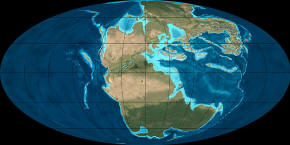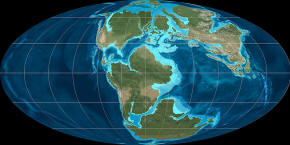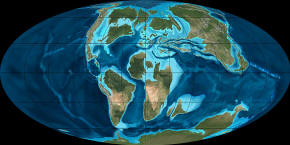| Triassic Period Geography | |
| During the Triassic, almost all the Earth's land mass was concentrated into a single supercontinent centered more or less on the equator, called Pangaea ("all the land"). From the east a vast gulf entered Pangaea, the Tethys sea. It opened farther westward in the mid-Triassic, at the expense of the shrinking Paleo-Tethys Ocean, an ocean that existed during the Paleozoic. The remaining shores were surrounded by the world-ocean known as Panthalassa ("all the sea"). |
 |
| Jurassic Period Geography | |
| During the early Jurassic period, the supercontinent Pangaea broke up into the northern supercontinent Laurasia and the southern supercontinent Gondwana; the Gulf of Mexico opened in the new rift between North America and what is now Mexico's Yucatan Peninsula. The Jurassic North Atlantic Ocean was relatively narrow, while the South Atlantic did not open until the following Cretaceous Period, when Gondwana itself rifted apart. The Tethys Sea closed, and the Neotethys basin appeared. Climates were warm, with no evidence of glaciation. As in the Triassic, there was apparently no land near either pole, and no extensive ice caps existed. |
 |
| Cretaceous Period Geography | |
| During the Cretaceous, the late-Paleozoic-to-early-Mesozoic supercontinent of Pangaea completed its tectonic breakup into present day continents, although their positions were substantially different at the time. As the Atlantic Ocean widened, the convergent-margin orogenies that had begun during the Jurassic continued in the North American Cordillera, as the Nevadan orogeny was followed by the Sevier and Laramide orogenies. Though Gondwana was still intact in the beginning of the Cretaceous, it broke up as South America, Antarctica and Australia rifted away from Africa (though India and Madagascar remained attached to each other); thus, the South Atlantic and Indian Oceans were newly formed. Such active rifting lifted great undersea mountain chains along the welts, raising eustatic sea levels worldwide. To the north of Africa the Tethys Sea continued to narrow. Broad shallow seas advanced across central North America (the Western Interior Seaway) and Europe, then receded late in the period, leaving thick marine deposits sandwiched between coal beds. At the peak of the Cretaceous transgression, one-third of Earth's present land area was submerged. |
 |
Climate
During most of the Mesozoic global temperatures were warmer than the are today. For example, the average tempurature during the Triassic was 17°C (63°F), which is 3°C higher than the average today. This fluctuated throughout the Era, reaching 4°C higher during the Cretaceous.
The Triassic was generally dry, a trend that began in the late Carboniferous, and highly seasonal, especially in the interior of Pangaea. Low sea levels may have also exacerbated temperature extremes. With its high specific heat capacity, water acts as a temperature-stabilizing heat reservoir, and land areas near large bodies of water—especially the oceans—experience less variation in temperature. Because much of the land that constituted Pangaea was distant from the oceans, temperatures fluctuated greatly, and the interior of Pangaea probably included expansive areas of desert.
Sea levels began to rise during the Jurassic, which was probably caused by an increase in seafloor spreading. The formation of new crust beneath the surface displaced ocean waters by as much as 200 m (656 ft) more than today, which flooded coastal areas. Furthermore, Pangaea began to rift into smaller divisions, bringing more land area in contact with the ocean by forming the Tethys Sea. Temperatures continued to increase and began to stabilize. Humidity also increased with the proximity of water, and deserts retreated.
During the Cretaceous, the Berriasian age showed a cooling trend that had been seen in the last epoch of the Jurassic. There is evidence that snowfalls were common in the higher latitudes and the tropics became wetter than during the Triassic and Jurassic. Glaciation was however restricted to alpine glaciers on some high-latitude mountains, though seasonal snow may have existed farther south. Rafting by ice of stones into marine environments occurred during much of the Cretaceous but evidence of deposition directly from glaciers is limited to the Early Cretaceous of the Eromanga Basin in southern Australia. After the end of the Berriasian, however, temperatures increased again, and these conditions were almost constant until the end of the period. This trend was due to intense volcanic activity which produced large quantities of carbon dioxide. The production of large quantities of magma, variously attributed to mantle plumes or to extensional tectonics, further pushed sea levels up, so that large areas of the continental crust were covered with shallow seas. The Tethys Sea connecting the tropical oceans east to west also helped in warming the global climate. Warm-adapted plant fossils are known from localities as far north as Alaska and Greenland, while dinosaur fossils have been found within 15 degrees of the Cretaceous south pole. A very gentle temperature gradient from the equator to the poles meant weaker global winds, contributing to less upwelling and more stagnant oceans than today. This is evidenced by widespread black shale deposition and frequent anoxic events
The amount of oxygen in the Mesozoic atmosphere varied widely, but was significantly higher on average (~26%) than in today's atmosphere (20 to 21%)
Life
The extinction of nearly all animal species at the end of the Permian period allowed for the radiation of many new lifeforms. In particular, the extinction of the large herbivorous and carnivorous dinocephalia left those ecological niches empty. Some were filled by the surviving cynodonts and dicynodonts, the latter of which subsequently became extinct. Some plant species had distributions that were markedly different from succeeding periods; for example, the Schizeales, a fern order, were skewed to the Northern Hemisphere in the Mesozoic, but are now better represented in the Southern Hemisphere.
Recent research indicates that the specialized animals that formed complex ecosystems, with high biodiversity, complex food webs and a variety of niches, took much longer to reestablish, recovery did not begin until the start of the mid-Triassic, 4M to 6M years after the extinction and was not complete until 30M years after the P-Tr extinction. Animal life was then dominated, by large archosaurian reptiles: dinosaurs, pterosaurs, and aquatic reptiles such as ichthyosaurs, plesiosaurs, and mosasaurs.
The climatic changes of the late Jurassic and Cretaceous provided for further adaptive radiation. The Jurassic was the height of archosaur diversity, and the first birds and placental mammals also appeared. Angiosperms radiated sometime in the early Cretaceous, first in the tropics, but the even temperature gradient allowed them to spread toward the poles throughout the period. By the end of the Cretaceous, angiosperms dominated tree floras in many areas, although some evidence suggests that biomass was still dominated by cycad and ferns until after the KT extinction.
Some have argued that insects diversified with angiosperms because insect anatomy, especially the mouth parts, seems particularly well-suited for flowering plants. However, all major insect mouth parts preceded angiosperms and insect diversification actually slowed when they arrived, so their anatomy originally must have been suited for some other purpose.
As the temperatures in the seas increased, the larger animals of the early Mesozoic gradually began to disappear while smaller animals of all kinds, including lizards, snakes, and perhaps primates, evolved. The KT extinction exacerbated this trend. The large archosaurs became extinct, while birds and mammals thrived, as they do today.
Return to the Old Earth Ministries Online Dinosaur Curriculum homepage.